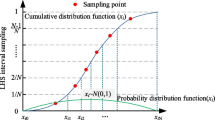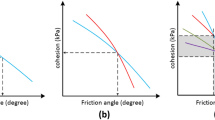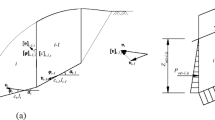Abstract
Small variation in shear strength parameters results in remarkable changes in the safety factor (SF) of a rock slope. In this regard, rock mass strength of a failed slope can be estimated with reasonable accuracy using back analysis approach. The conventional back analysis (BA) procedure is based on trial and error approach on the mb and s parameters of Hoek–Brown failure criterion in conjunction with the Geological Strength Index (GSI) classification system. A new BA procedure presented in this paper, a functional relationship, that indicted all possible combinations of mb and s constants, was derived using stability analysis of a slope assuming that the SF of the slope is equal to unity. Then, another relationship is established between mb and s based on the magnitude of GSI. Intersection of the two relationships when plotting on a graph, defines a unique value for mb and s. Finally, effect of the constant a in the generalized Hoek–Brown failure criterion on the GSI value obtained from the method BA is discussed and its effect is considered in the BA approach. The most advantage of the proposed method is that a reliable GSI is obtained in a relatively short time. For better explanation of the new BA procedure, this method is used for the back analysis of a failed slope along the national railway of Iran. Comparing results obtained from the new BA approach and the traditional back analysis method well-specified which the new proposed BA approach increases the accuracy of parameter estimation.













Similar content being viewed by others
Data Availability
Data sharing is not applicable to this article as no new data were created or analyzed in this study.
References
Akin M (2013) Slope stability problems and back analysis in heavily jointed rock mass: a case study from Manisa, Turkey. Rock Mech Rock Eng 46:359–371
Armaghani DJ, Bayat V, Koopialipoor M, Pham BT (2021) Investigating the effect of jointed environment on the cracked concrete arch dam in 3D conditions using FEM. Bull Eng Geol Environ 80:55–70
Cai M, Kaiser PK, Tasaka Y, Minami M (2007) Determination of residual strength parameters of jointed rock masses using the GSI system. Int J Rock Mech Min Sci 44:247–265
Callisto L, Ricci C (2019) Interpretation and back-analysis of the damage observed in a deep tunnel after the 2016 Norcia earthquake in Italy. Tunn Undergr Sp Technol 89:238–248
Feng P (1997) Probabilistic treatment of the sliding wedge
Gao W, Ge M (2016) Back analysis of rock mass parameters and initial stress for the Longtan tunnel in China. Eng Comput 32:497–515
Gioda G, Sakurai S (1987) Back analysis procedures for the interpretation of field measurements in geomechanics. Int J Numer Anal Methods Geomech 11:555–583
Hoek E (1988) The Hoek–Brown failure criterion-a 1988 update. In: Proceedings 15th Canadian rock mechanics symposium. Department of Civil Engineering, University of Toronto, pp 31–38
Hoek E (2007) Practical rock engineering. 2007. Online ed Rocscience
Hoek E, Brown ET (1997) Practical estimates of rock mass strength. Int J Rock Mech Min Sci 34:1165–1186
Hoek E, Carranza-Torres C, Corkum B (2002) Hoek-Brown failure criterion-2002 edition. Proc NARMS-Tac 1:267–273
International A (2014) ASTM C39: standard test method for compressive strength of cylindrical concrete specimens
Kirsten HAD, HAD K (1976) Determination of rock mass elastic moduli by back analysis of deformation measurements
Koopialipoor M, Tootoonchi H, Marto A, et al (2018) Various effective factors on peak uplift resistance of pipelines in sand: a comparative study. Int J Geotech Eng 1–8
Li AJ, Merifield RS, Lyamin AV (2008) Stability charts for rock slopes based on the Hoek–Brown failure criterion. Int J Rock Mech Min Sci 45:689–700
Merifield RS, Lyamin AV, Sloan SW (2006) Limit analysis solutions for the bearing capacity of rock masses using the generalised Hoek–Brown criterion. Int J Rock Mech Min Sci 43:920–937
Miranda T, Dias D, Eclaircy-Caudron S et al (2011) Back analysis of geomechanical parameters by optimisation of a 3D model of an underground structure. Tunn Undergr Sp Technol 26:659–673
Molaghab A, Taherynia MH, Aghda SMF, Fahimifar A (2017) Determination of minimum and maximum stress profiles using wellbore failure evidences: a case study—a deep oil well in the southwest of Iran. J Pet Explor Prod Technol 7:707–715
Najm K, Narimani GFA (1992) Stability analysis of Keshwar tunnel. In: Paper presented at the first seminar on Landslides and reduces its damages, Theran, Iran, 1992
Öge İF (2017) Investigation of design parameters of a failed soil slope by back analysis. Eng Fail Anal 82:266–279
Popescu ME, Schaefer VR (2008) Landslide stabilizing piles: a design based on the results of slope failure back analysis. Landslides Eng Slopes from Past to Futur 1:1787–1793
Priest SD (2005) Determination of shear strength and three-dimensional yield strength for the Hoek–Brown criterion. Rock Mech Rock Eng 38:299–327
Rocscience (2010) SLIDE, version 6.0_2D Limit equilibrium slope stability analysis. Rocscience Inc., Toronto, Ontario, Canada, version 6.0 edn
Sakurai S (1974) Determination of initial stresses and mechanical properties of viscoelastic underground medium. In: Proceedings 3rd ISRM congress, 1974
Sharifzadeh M, Sharifi M, Delbari SM (2010) Back analysis of an excavated slope failure in highly fractured rock mass: the case study of Kargar slope failure (Iran). Environ Earth Sci 60:183–192
Shen J (2013) Analytical and numerical analyses for rock slope stability using the generalized Hoek–Brown criterion
Sonmez H, Ulusay R (1999) Modifications to the geological strength index (GSI) and their applicability to stability of slopes. Int J Rock Mech Min Sci 36:743–760
Sonmez H, Ulusay R (2002) A discussion on the Hoek-Brown failure criterion and suggested modifications to the criterion verified by slope stability case studies. Yerbilimleri 26:77–99
Sonmez H, Ulusay R, Gokceoglu C (1998) A practical procedure for the back analysis of slope failures in closely jointed rock masses. Int J Rock Mech Min Sci 35:219–233
Sonmez H, Gokceoglu C, Ulusay R (2003) An application of fuzzy sets to the geological strength index (GSI) system used in rock engineering. Eng Appl Artif Intell 16:251–269
Soori S, Lasharipour GR, Ghafoori MF (2013) Prioritization of landslide effective factors and its hazard mapping using AHP model (A case study: Keshvari watershed). J Iran Assoc Enfineering Geol 6:1–12
Tajduś K (2010) Determination of approximate value of a GSI Index for the disturbed rock mass layers in the area of Polish coal mines. Arch Min Sci 55:879–890
Ulusay R, Arikan F, Yoleri MF, Çaǧlan D (1995) Engineering geological characterization of coal mine waste material and an evaluation in the context of back-analysis of spoil pile instabilities in a strip mine, SW Turkey. Eng Geol 40:77–101
Ulusay R, Yucel Z (1989) An example for the stability of slopes exca vated in weak rocks: Baskoyak Barite Open Pit. Earthsciences, Bull of Earth Sciences Application and Research Center of Hacettepe University 15(2):15–27 ((in Turkish))
Vardakos S, Gutierrez M, Xia C (2016) Back-analysis of tunnel response from field monitoring using simulated annealing. Rock Mech Rock Eng 49:4833–4852
Wang L, Hwang JH, Luo Z et al (2013) Probabilistic back analysis of slope failure–a case study in Taiwan. Comput Geotech 51:12–23
Wyllie M (2004) Rock slope engineering, civil and mining. In: 4th SPONPRESS
Yang X-L, Yin J-H (2010) Slope equivalent Mohr-Coulomb strength parameters for rock masses satisfying the Hoek–Brown criterion. Rock Mech Rock Eng 43:505–511
Yazdani M, Sharifzadeh M, Kamrani K, Ghorbani M (2012) Displacement-based numerical back analysis for estimation of rock mass parameters in Siah Bisheh powerhouse cavern using continuum and discontinuum approach. Tunn Undergr Sp Technol 28:41–48
Zhang LQ, Yue ZQ, Yang ZF et al (2006) A displacement-based back-analysis method for rock mass modulus and horizontal in situ stress in tunneling–Illustrated with a case study. Tunn Undergr Sp Technol 21:636–649
Zhang X, Bayat V, Koopialipoor M et al (2020) Evaluation of structural safety reduction due to water penetration into a major structural crack in a large concrete project. Smart Struct Syst 26:319–329
Acknowledgment
The authors wish to thank the Training and Research Center of the Railways of Islamic Republic of Iran for financial support for the research project of Keshvar tunnel.
Author information
Authors and Affiliations
Corresponding author
Ethics declarations
Conflict of interest
The authors declared that there is no conflict of interest to this work.
Additional information
Publisher's Note
Springer Nature remains neutral with regard to jurisdictional claims in published maps and institutional affiliations.
Rights and permissions
About this article
Cite this article
Taherynia, M.H., Koopialipoor, M., Azizzadeh, A. et al. Investigation of Failed Slopes Based on a New Method of Back Analysis in Rock Masses: A Case Study. Geotech Geol Eng 39, 5119–5133 (2021). https://doi.org/10.1007/s10706-021-01818-8
Received:
Accepted:
Published:
Issue Date:
DOI: https://doi.org/10.1007/s10706-021-01818-8




